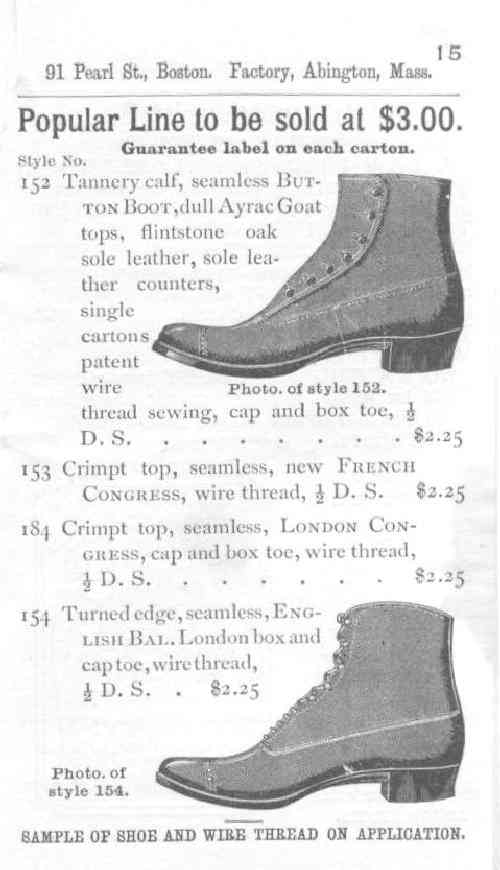
J.B. Lewis Boot and Shoe Company Product Line (1887-88)

Figure 1.--We note J.B. Lewsis in its 1987-88 catalog using the term "English Bal" referring to Balmoral style footwear. Balmoral is of course located in Scotland. As Balmoral a residence of the British royal family, the style is linked with the royal family.
|
|
We notice pages from a J.B. Lewis Boot and Shoe Company catalog for 1987-88. The company was a manufacturr. It was located in Boston and had a manufacturing plant in Abingdon. The catalog described the company's product line and prices. All the styles we note were high-top footwear. We note a special page for school shoes which look more like boots.
We do not know when the company was estanlished, but the catalog here shows that it was an established company in the 1880s. We notice pages from a J.B. Lewis Boot and Shoe Company catalog for 1987-88. The company was a manufacturr. It was located in Boston and had a manufacturing plant in Abington. We know nothing more about the company at this time.
Product Line
The catalog described the company's product line and prices. All the styles we note were high-top footwear. We note a special page for school shoes which look more like boots. We also notice references to Balmoral or Bal style footwear. We are unsure how far back the balmoral term was used. Note that the ad copy here refers to English as opposed to Scotch.
I assume that the author knew of the British usage in shoe design, but di not connect te term Balmoral with Queen Victoria's residence in Scotland.
Bal style
On page 15 at the bottom is a laced boot described as: 154 Turned edge, seamless, English Bal. London box and cap toe, wire thread. 1/2 D.S. . $2.25 " This shows that the company was using the term "bal" in the 1880s to describe a shoe with a line (seam?) around the bottom of the laced area and extending to the back of the boot. I would conclude that this is an English style with shoe laces rather than buttons. Webster's Dictionary defines a balmoral as a "woman's short walking boot worn in the 19th century". This seems to be inaccurate in a number of regards. It is used here as a shoe style for men, women and children. Although shaped like what we would today call a boot, it was at the time considered to be a shoe. A key aspect of the balmoral is clearly laces rather than buttons.
On page 29 are two School Shoes. In the middle of the page it states:"English Balmorals at 5 cents less than Button Boots." I do not fully understand the various construction details mentioned here. Balmorals would seem, however, to be a laced "shoe. Apparently lace up shoes were preceived at the time to be an English style. I'mnot sure how popular these balmoral styles shoes were. Most of the period portraits we have noted seem to be button rather than lace up shoes.
Er notice the term Balmoral-style being used in connection
With saddle shoesin the 20th century. The references here help to explain the Balmoral style of sattle shoe. Someone must have adopted the term balmoral to differentiate the type with the design (saddle part) continuous below the laces as opposed to the blucher which is not continuous.
HBC

Navigate the Boys' Historical Clothing catalog/magazine pages:
[Return to the Main American mail order 1887 page]
[Return to the Main American mail order 1880s page]
[Return to the Main U.S. catalog chronology page]
[Main photo/publishing page]
[Store catalogs]
[Fashion magazines]
Navigate the Boys' Historical Clothing Web Site:
[Introduction]
[Activities]
[Biographies]
[Chronology]
[Cloth and textiles]
[Clothing styles]
[Countries]
[Topics]
[Bibliographies]
[Contributions]
[FAQs]
[Glossaries]
[Satellite sites]
[Tools]
[Boys' Clothing Home]
Navigate the Boys' Historical Clothing Web Site:
[Headwear]
[Sailor hats]
[Dresses]
[Kilts]
[Buster Brown suits]
[Eton suits]
[Sailor suits]
[Rompers]
[Tunics]
[Smocks]
[Pinafores]
[Coats]
[Long stockings]
[Underwear]
Created: 1:20 AM 3/27/2005
Last updated: 1:20 AM 3/27/2005



